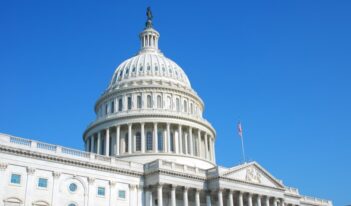
ACUS recommends transparency and oversight be provided whenever agencies collect user fees.
In addition to collecting taxes, the federal government collects hundreds of billions of dollars every year in the form of user fees. User fees are typically assessed by an agency in exchange for a provided good or service. For example, the United States Customs Service operated exclusively on the basis of fees for its first 60 years. In the 1790s, the United States Postal Service supported itself with fees, not taxes. Today, a seven-day pass to Grand Canyon National Park costs $35 per vehicle, a first-class stamp costs 68 cents, and the U.S. Department of State collects $130 to issue a U.S. passport. Some user fees are less visible—for instance, the cost of an airplane ticket includes small user fees paid to U.S. Customs and Border Protection to fund inspections.
In the late 1980s, the Administrative Conference of the United States (ACUS) commissioned a report to explore the propriety of user fees. The resulting report focused on the use of fees to improve the efficiency of government services. In short, the report explained that user fees require beneficiaries of a good or service to pay the cost of providing it. The resulting demand, the report concluded, will therefore indicate to the government exactly how much of the good or service to provide. Following that report, ACUS recommended that user fees be linked to services that directly benefit the payer and that fee amounts be based on market prices whenever possible.
In the decades since the 1980s, the federal government has become increasingly reliant on user fees. Overall, it collected $571.6 billion in 2022—more than three times the amount collected twenty years ago. Today, hundreds of user fees exist across dozens of agencies, and a new model for fees has emerged. In addition to charging businesses and individuals for specific goods and services, the government charges the companies and industries it regulates.
Broadly worded legislation from the middle of the 20th Century authorizes agencies to craft user fee programs on their own initiative, using rulemaking. An agency, however, may not collect a fee under this law from a company that does not receive a special benefit from the agency. As a result, many modern user fee programs are authorized instead by separate statutory provisions. These statutes vary. Some statutes set the fee amounts, while others broadly authorize the agency in question to recover its operating costs through fees.
In 2023, ACUS retained me as a consultant to examine user fees, focusing on the design of fee programs—both the design choices and the designing process. It turned out that there is no authoritative public list of federal agency user fees, so constructing a complete list was a critical threshold task. The resulting table identified hundreds of user fee programs at 52 federal agencies. I examined a subset more closely, trying to ensure some diversity in the choices—looking at agencies that are fully funded by user fees as well as agencies that are not, for example, and looking at agencies that use the mid-century statutory authority as well as agencies that have newer and more prescriptive user fee statutes.
This project entailed not only a literature review and extensive primary source research, but also interviews. I spoke with officials at the Agricultural Marketing Service, Customs and Border Protection, Environmental Protection Agency, Nuclear Regulatory Commission, Securities and Exchange Commission, United States Citizenship and Immigration Services, and U.S. Patent and Trademark Office. I also spoke with staff of the American Intellectual Property Law Association about fees charged by the Patent and Trademark Office and with staff from Public Citizen about prescription drug user fees charged by the Food and Drug Administration.
The final report, submitted in November 2023, told the history of user fee programs in this country, noting several important constitutional issues resolved in the 1970s as well as several that remain open today. It then tackled the initial question faced by lawmakers and agency staff: whether to impose a user fee in the first case. The heart of the report analyzed design and implementation choices grouped around four topics: setting user fees, collecting user fees, using collected fees, and reviewing user fees and user fee programs. The diversity of user fee programs across the federal government, and the fact that user fee program design necessarily reflects an agency’s substantive mission, required the discussion to be very high-level.
The report concluded with several recommendations directed to decision makers at both the legislative and administrative levels. First, transparency during the user fee design process and about the decisions is essential, and some degree of stakeholder involvement will be important.
Second, policymakers should pay attention to the possibility that fee imposition, the structure of the fee program, or fee amounts could distort either agency decision making or private behaviors in ways that are not socially desirable. The classic concern is that collecting fees to support programs prompts an agency to favor the interests of regulated feepayers. But this recommendation was meant to cast a wider net.
Third, policymakers should not forget the nature and consequences of an agency being partly or fully dependent on user fees. In some cases, for instance, decision makers may want to create a reserve fund so that important regulatory programs are not placed at risk because collections are hard to predict. In other cases, to give another example, being fully fee-funded may discourage agency staff from administering waivers and exemptions (to the user fees) that would be socially beneficial but require resources to implement.
Finally, although program designers and scholars have historically justified transactional user fees on economic efficiency grounds, there may be persuasive reasons to take other values, goals, and priorities into account when deciding whether to collect fees and how to structure fee programs. Put another way, resource enhancement and economic efficiency may not be the only values that matter and other considerations—such as concern that perceptions of capture may undermine public confidence in the agency—may counsel against collecting a user fee or may suggest structuring the fee a particular way.
In December 2023, after reviewing my report, ACUS issued a new eleven-part recommendation for Congress and agencies. It indicated that program’s designers should consider whether any feature of a user fee program might inappropriately affect or be perceived as inappropriately affecting agency decision making and whether any steps should be taken to mitigate those effects.
It recommended that Congress “maintain oversight of agencies that operate user fee programs, such as through the appropriations process or authorizing legislation that specifies the purpose, time, and availability for money collected through user fee programs.”
It advised that “when an agency establishes a new user fee program or sets fees under an existing program, that agency follow the rulemaking requirements of 5 U.S.C. § 553 unless Congress has specified otherwise.”
Finally, ACUS also recommended greater transparency, indicating that agencies should “communicate clearly to the public the purposes of their user fee programs, the nature of the fee setting process, and the uses for which the agency expends collected fees,” and it asked that agencies provide detailed information on their websites about their user fee funded programs.
My report did not consider—and ACUS did not discuss—issues relating to the constitutionality of user fee programs. But I noted in passing in my report that there still remain important questions about the constitutionality of statutes that delegate to executive branch entities the power to raise money for their own use, especially if the money is available for an unlimited amount of time without any subsequent congressional involvement, and perhaps especially if the entity has broad discretion to design its own substantive programs. The Supreme Court recently found an unconventional agency funding mechanism acceptable in Consumer Financial Protection Bureau. But the mechanism was different from a user fee, and user fee statutes themselves vary wildly in the amount of discretion they grant the implementing agencies. Constitutional questions will likely still have salience in coming years, which should make the research and findings in this ACUS report of continuing interest.
This essay is part of a series of essays titled, “Moving Administrative Processes Forward, Together.”




